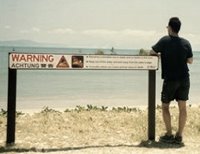
The coastal town of Broome sits somewhat isolated on the northern slope of Western Australia. We settled there, several days ago, after an eleven hundred mile drive from Darwin, where the stifling humidity made it impossible to spend but one sleepless night. While the car stereo sang in the background, the two of us lazed about our campsite enjoying the comfortable breeze that blew off the Indian Ocean. When the music faded and the news began, its lead story highlighted a tragedy in Kakadu National Park. The headline told of a tourist snatched by a crocodile, and it alone sent a shiver up my spine. But as the reporter continued, the details absolutely chilled my blood.
Kakadu National Park covers three million acres in an area 150 miles east of Darwin. This UNESCO World Heritage Site ecosystem hosts over a thousand species of plant life, and in them, countless insects and animals play the cruel game of survival. However, one efficient killing machine inhabits this landscape with a notorious reputation rightfully earned. In the creeks and murky waters of the billabongs that dot Kakadu lurks the merciless and unforgiving Crocodylus porosus, or saltwater crocodile.
German tourists, Isabel von Jordan, and her sister narrowly escaped the Bali bombing when they left the Sari Club just moments before the blast. Having survived that nightmare, both flew to Darwin and the safety of Australia. They took a tour of Kakadu National Park with seven others and, in a moment of unspeakably poor judgment, decided on a late evening swim in Nourlangie Creek despite the posted signs warning of crocodiles. With safety assured by their negligent guide, seven of the nine jumped in the creek. Only six survived. Park Rangers found the mauled body of Isabel just after dawn the following morning.
Unfortunately, a second tragedy would play out before this story ended. As we discussed the facts that surrounded her death with an Australian couple camped next to us, we all agreed that “Saltie,” an affectionate nickname given by those not in the deadly grip of its jaws, would also become a victim of this senseless event. Ultimately destroyed by park officials as they recovered her body, the fifteen-foot reptile became another fatality in Kakadu's ruthless battle of life or death.
Kakadu National Park covers three million acres in an area 150 miles east of Darwin. This UNESCO World Heritage Site ecosystem hosts over a thousand species of plant life, and in them, countless insects and animals play the cruel game of survival. However, one efficient killing machine inhabits this landscape with a notorious reputation rightfully earned. In the creeks and murky waters of the billabongs that dot Kakadu lurks the merciless and unforgiving Crocodylus porosus, or saltwater crocodile.
German tourists, Isabel von Jordan, and her sister narrowly escaped the Bali bombing when they left the Sari Club just moments before the blast. Having survived that nightmare, both flew to Darwin and the safety of Australia. They took a tour of Kakadu National Park with seven others and, in a moment of unspeakably poor judgment, decided on a late evening swim in Nourlangie Creek despite the posted signs warning of crocodiles. With safety assured by their negligent guide, seven of the nine jumped in the creek. Only six survived. Park Rangers found the mauled body of Isabel just after dawn the following morning.
Unfortunately, a second tragedy would play out before this story ended. As we discussed the facts that surrounded her death with an Australian couple camped next to us, we all agreed that “Saltie,” an affectionate nickname given by those not in the deadly grip of its jaws, would also become a victim of this senseless event. Ultimately destroyed by park officials as they recovered her body, the fifteen-foot reptile became another fatality in Kakadu's ruthless battle of life or death.